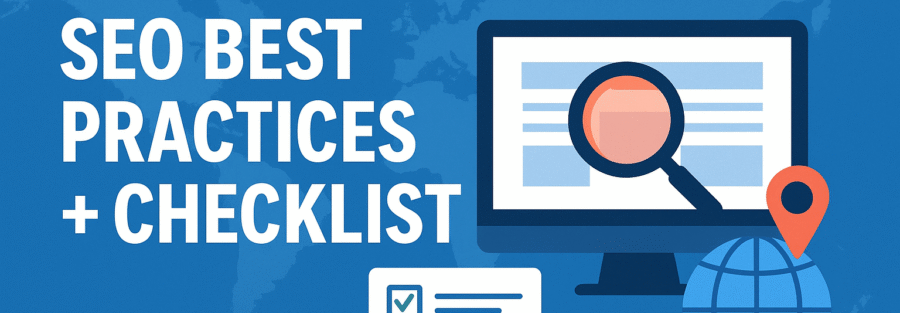Expanding your business globally opens up enormous opportunities—but it also brings challenges, especially when it comes to online visibility. A website that performs well in one country may not automatically succeed in another. That’s where International SEO comes in.
International SEO is the process of optimizing your website to attract organic traffic from multiple countries and languages. It ensures that search engines understand which version of your website should be shown to users in different regions, ultimately helping you reach the right audience with the right content.
In this guide, we’ll cover 10 International SEO best practices and provide a handy checklist to help you implement them.
- Define Your International Target Markets
Before diving into technical SEO, start with clarity. Identify which countries or languages you want to target. For instance, are you looking to expand from India into the Middle East, Europe, or the U.S.? Or do you want to serve Spanish speakers globally?
Checklist:
- Research where your product/service demand is highest.
- Use tools like Google Analytics, Google Trends, and SEMrush to analyze international traffic.
- Choose whether to target specific countries (geo-targeting) or language groups (language targeting).
- Choose the Right Website Structure
Your website structure plays a huge role in international SEO. You need to signal to search engines and users that your website is tailored for specific countries or languages.
Options include:
- ccTLDs (Country Code Top-Level Domains): e.g., example.fr for France.
- Subdomains: e.g., fr.example.com.
- Subdirectories: e.g., example.com/fr/.
Checklist:
- Pick a structure based on resources and long-term scalability.
- ccTLDs are strongest for local trust but require more effort.
- Subdirectories are easier to manage and often preferred by global brands.
- Implement Hreflang Tags Correctly
Hreflang is one of the most critical elements of international SEO. It tells search engines which language and regional version of a page should be shown to users.
For example:
<link rel=”alternate” hreflang=”en-gb” href=”https://example.com/uk/” />
Checklist:
- Use correct ISO language and country codes (e.g., en-us, fr-ca).
- Ensure every page references its alternates.
- Double-check hreflang tags for consistency—incorrect implementation can confuse search engines.
- Translate Content, Don’t Just Translate Words
International SEO isn’t only about technical tweaks—it’s also about providing value to users in their own language and culture. Machine translation often misses nuances, leading to poor user experience.
Checklist:
- Use professional translators or native speakers.
- Adapt cultural references, idioms, and examples.
- Consider local search behavior and keywords rather than direct translation.
- Optimize for Local Search Engines
Google dominates globally, but it’s not the only search engine. For example, Yandex is popular in Russia, and Baidu dominates in China. Each search engine has different ranking factors.
Checklist:
- Research the leading search engines in your target market.
- Understand their algorithms (e.g., Baidu prioritizes simplified Chinese content, fast-loading websites in China, and government licenses).
- Submit your site to relevant regional search engines where applicable.
- Conduct Local Keyword Research
Keyword intent varies across regions. A phrase that’s popular in the U.S. might not be relevant in the U.K., even if both audiences speak English.
Checklist:
- Use tools like Ahrefs, SEMrush, or Google Keyword Planner filtered by country.
- Identify local slang and buying terms (e.g., “trainers” in the U.K. vs. “sneakers” in the U.S.).
- Align keyword usage with cultural differences and seasonal trends.
- Localize User Experience (UX)
Localization goes beyond language. Currency, date formats, time zones, images, and even colors may need adaptation to suit local preferences.
Checklist:
- Display prices in local currency.
- Adapt forms for local address and phone number formats.
- Offer local payment methods and shipping options.
- Customize visuals and symbols for cultural appropriateness.
- Strengthen Local Backlinks
Backlinks are still a core ranking factor in SEO. For international SEO, backlinks from local domains and websites signal authority in that region.
Checklist:
- Build relationships with local influencers, bloggers, and media outlets.
- Submit your business to local directories.
- Partner with regional businesses for co-marketing campaigns.
- Ensure Fast Loading Across Regions
Website speed can make or break international SEO, especially in regions with slower internet connectivity.
Checklist:
- Use Content Delivery Networks (CDNs) to serve content closer to users.
- Compress images and enable browser caching.
- Test site speed with tools like GTmetrix or PageSpeed Insights for multiple countries.
- Monitor, Analyze, and Refine
International SEO is not a one-time project; it requires ongoing monitoring. Different countries may show different search patterns over time.
Checklist:
- Track rankings separately for each region and language.
- Monitor traffic and conversion rates with Google Analytics or GA4.
- Use Google Search Console’s International Targeting report to catch errors.
- Regularly audit hreflang tags, local content, and backlinks.
International SEO Checklist (Quick Reference)
✅ Define international target markets
✅ Choose the right domain structure (ccTLD, subdomain, subdirectory)
✅ Implement hreflang tags correctly
✅ Translate and localize content
✅ Optimize for local search engines (Google, Yandex, Baidu, etc.)
✅ Conduct local keyword research
✅ Adapt UX with cultural and regional relevance
✅ Build local backlinks
✅ Improve global site speed with CDN and optimization
✅ Monitor performance and refine strategies continuously
International SEO is both a technical and cultural exercise. While the technical side ensures search engines deliver the right version of your website, the cultural side ensures users feel at home when browsing.
By following these 10 best practices and keeping the checklist handy, your business can expand globally with confidence, increase visibility, and build meaningful connections with international audiences.




